Islamic Depictions of Mohammed in Full
Medieval Muslim artists often created paintings and illuminated manuscripts depicting Mohammed in full. Several examples are presented here. Other artists of the era drew Mohammed, but left his face blank so as to technically comply with a sporadically enforced Islamic ban on depicting the Prophet; these faceless images are shown in the second section of the Archive.
In 1999, Islamic art expert Wijdan Ali wrote a scholarly overview of the Muslim tradition of depicting Mohammed, which can be downloaded here in pdf format. In that essay, Ali demonstrates that the prohibition against depicting Mohammed did not arise until as late as the 16th or 17th century, despite the media's recent false claims that it has always been forbidden for Muslims to draw Mohammed. Until comparatively recently in Islamic history, it was perfectly common to show Mohammed, either in full (as revealed on this page), or with his face hidden (as shown on the next page). Even after the 17th century, up to modern times, Islamic depictions of Mohammed (especially in Shi'ite areas) continued to be produced.
On this page are many examples of full-faced Mohammed portraits produced by Muslim artists across the centuries. Attributions for each image are given where known.
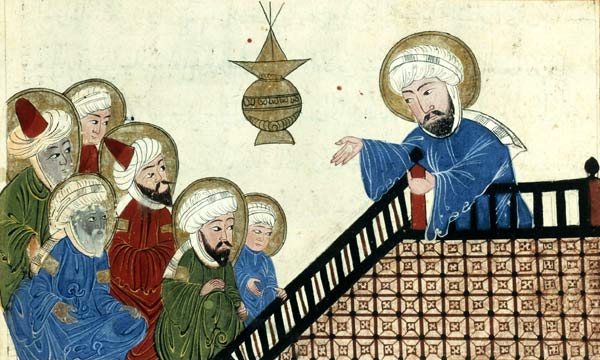
Illustration showing Mohammed (on the right) preaching his final sermon to his earliest converts, on Mount Ararat near Mecca; taken from a medieval-era manuscript of the astronomical treatise The Remaining Signs of Past Centuries by the Persian scholar al-Biruni; currently housed in the collection of the Bibliotheque Nationale, Paris (Manuscrits Arabe 1489 fol. 5v). This scene was popular among medieval Islamic artists, and several nearly identical versions of this drawing (such as this one [shown in detail below] and this one) were made in the Middle Ages.
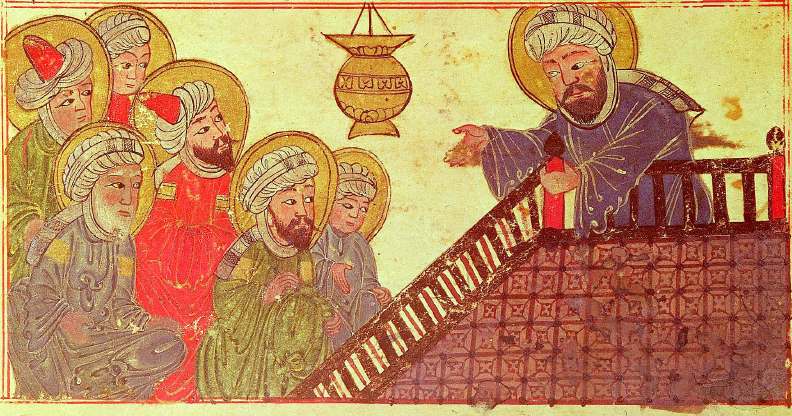
Another version of the previous drawing (almost exactly the same, but with minor differences) , this one taken from a 13th-century Persian manuscript (most likely a different edition of al-Biruni's The Remaining Signs of Past Centuries) housed at the Edinburgh University Library, Scotland.

Detail of Mohammed from the picture above.
The image shown above was censored by the French textbook company Belin Editions in 2005. As explained and illustrated on this French-language Web site (an English translation of which you can find here), the April 2005 edition of their history and geography textbook had this original picture of Mohammed with his face visible; but the subsequent edition, from August 2005, had his face blotted out by the editors, in a misguided attempt to be politically sensitive.
(Hat tip: Gilles C.)

Mohammed's Flight from Mecca in 622 AD; Algerian color postcard from the 1920s or '30s. Mohammed is the figure entering the cave. The original postcard is in a private collection.
(Hat tip: Martin H.)

Mohammed receiving his first revelation from the angel Gabriel. Miniature illustration on vellum from the book Jami' al-Tawarikh (literally "Compendium of Chronicles" but often referred to as The Universal History or History of the World), by Rashid al-Din, published in Tabriz, Persia, 1307 A.D. Now in the collection of the Edinburgh University Library, Scotland.

Detail of Mohammed from the picture above.

A young Mohammed being recognized by the monk Bahira. Miniature illustration on vellum from the book Jami' al-Tawarikh (literally "Compendium of Chronicles" but often referred to as The Universal History or History of the World), by Rashid al-Din, published in Tabriz, Persia, 1307 A.D. Now in the collection of the Edinburgh University Library, Scotland.

Detail of the young Mohammed from the image above.

Mohammed solves a dispute over lifting the black stone into position at the Kaaba. The legends tell how, when Mohammed was still a young man, the Kaaba was being rebuilt and a dispute arose between the various clans in Mecca over who had the right rededicate the black stone. (The Kaaba was at that time still a polytheistic shrine, this being many years before Islam was founded.) Mohammed resolved the argument by placing the stone on a cloth and having members of each clan lift the cloth together, raising the black stone into place cooperatively. Miniature illustration on vellum from the book Jami' al-Tawarikh (literally "Compendium of Chronicles" but often referred to as The Universal History or History of the World), by Rashid al-Din, published in Tabriz, Persia, 1307 A.D. Now in the collection of the Edinburgh University Library, Scotland.
(Hat tip: Brett K. and Martin H.)

Detail of Mohammed from the picture above.

Mohammed's birth. Miniature illustration on vellum from the book Jami' al-Tawarikh (literally "Compendium of Chronicles" but often referred to as The Universal History or History of the World), by Rashid al-Din, published in Tabriz, Persia, 1307 A.D. Now in the collection of the Edinburgh University Library, Scotland. (This image can be found online here.)
(Hat tip: Jos.)

Detail of the baby Mohammed from the painting above.
(Hat tip: Nils.)

The Mi'raj (also called the "Night Ride") of Mohammed on Buraq. Miniature illustration on vellum from the book Jami' al-Tawarikh (literally "Compendium of Chronicles" but often referred to as The Universal History or History of the World), by Rashid al-Din, published in Tabriz, Persia, 1307 A.D. Now in the collection of the Edinburgh University Library, Scotland.

Detail of Mohammed from the picture above.

Mohammed (on the far right) and Abu Bakr on their way to Medina while a woman milks a herd of goats. Miniature illustration on vellum from the book Jami' al-Tawarikh (literally "Compendium of Chronicles" but often referred to as The Universal History or History of the World), by Rashid al-Din, published in Tabriz, Persia, 1307 A.D. Now in the collection of the Edinburgh University Library, Scotland.

Mohammed on his deathbed. Miniature illustration on vellum from the book Jami' al-Tawarikh (literally "Compendium of Chronicles" but often referred to as The Universal History or History of the World), by Rashid al-Din, published in Tabriz, Persia, 1307 A.D. Now in the collection of the Edinburgh University Library, Scotland.
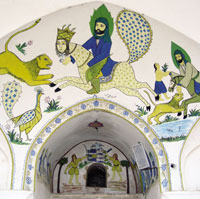
This Iranian site contains a photograph of a mural which appears to depict Mohammed (sixth picture down) on a contemporary building in Iran. The mural shows Buraq (the animal that carried Mohammed on his Night Voyage, described as being white and having the face of a woman and the tail of a peacock, which this creature is and does) carrying a figure who could therefore only be Mohammed. A word-for-word transliteration of the Farsi caption to that picture is (according to this automated translation site), "The Messenger mounted mainland shiny door village (yzdlaan) (kvyry) village blinds to ascension wine river," which obviously doesn't translate well but which does make mention of "The Messenger," a traditional epithet for Mohammed (as the messenger of Allah). Note: this image is hosted on the Web site of the Iranian newspaper Hamshahri, which is sponsoring a contest of cartoons about the Holocaust as an outraged reponse to the publication of the Mohammed cartoons in the West. Yet the newspaper itself is currently displaying this depiction of Mohammed. (This image also on the newspaper's site appears to be a different modern image of Mohammed as well.) [UPDATE: All the images linked to in this caption have now been taken offline by the Hamshahri newspaper, apparently after having been exposed here; the search-engine caches for the pages have also now expired, meaning that the small photo shown above is the only known surviving image of this unusual contemporary Mohammed depiction.]
(Hat tip: Kilgore Trout.)
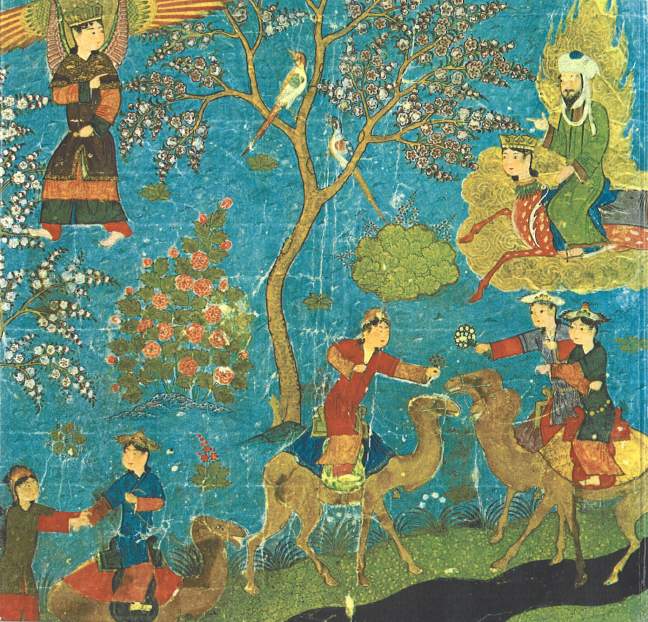
Mohammed (upper right) visiting Paradise while riding Buraq, accompanied by the Angel Gabriel (upper left). Below them, riding camels, are some of the fabled houris of Paradise -- the "virgins" promised to heroes and martyrs. This image and the following five images are Persian, 15th century, from a manuscipt entitled Miraj Nama, which is in the Bibliotheque Nationale, Paris. Taken from The Miraculous Journey of Mahomet, by Marie-Rose Seguy.
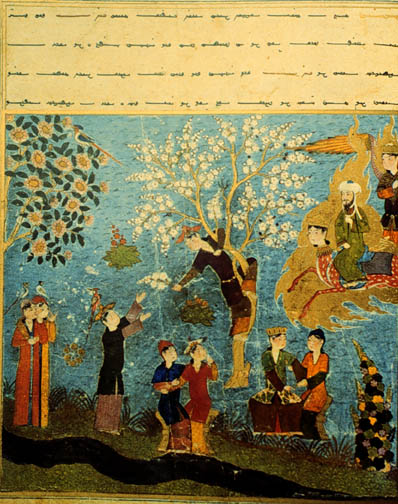
Mohammed, flying over Paradise, looks at the houris harvesting flowers and enjoying themselves. Persian, 15th century.

Mohammed, along with Buraq and Gabriel, visit Hell, and see a demon punishing "shameless women" who had exposed their hair to strangers. For this crime of inciting lust in men, the women are strung up by their hair and burned for eternity. Persian, 15th century.

Next, Mohammed sees women strung up by hooks thrust through their tongues by a green demon. Their crimes were to "mock" their husbands and to leave their homes without permission. Persian, 15th century.
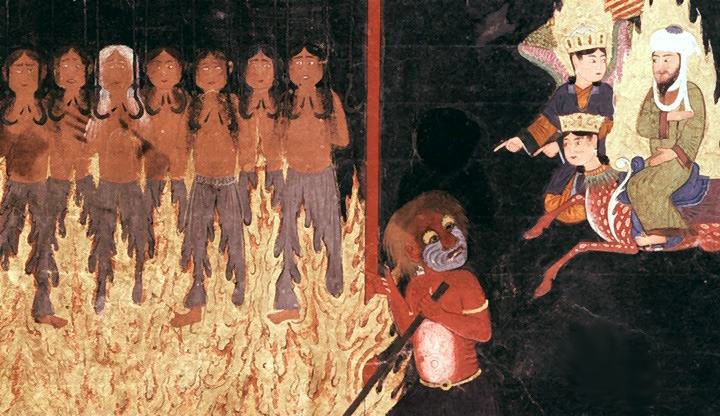
Further on, Mohammed sees a red demon that is torturing women by hanging them up by hooks through their breasts, as they are engulfed in flames. The women are being punished for giving birth to illegitimate children whom they falsely claimed were fathered by their husbands. Persian, 15th century.
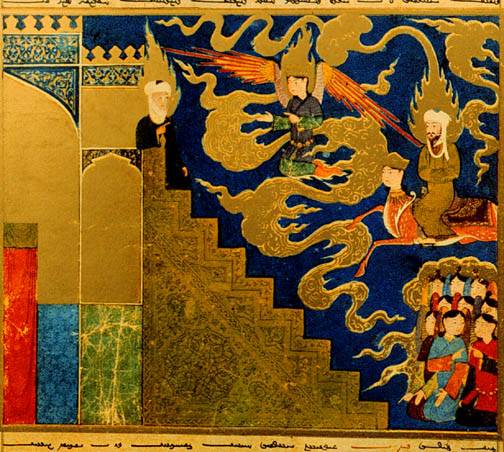
Mohammed (on the right, astride Buraq) and the Angel Gabriel (center) talk with Abraham (left) in Paradise. Persian, 15th century.
Another illustration apparently from the same series in this manuscript can be seen here.
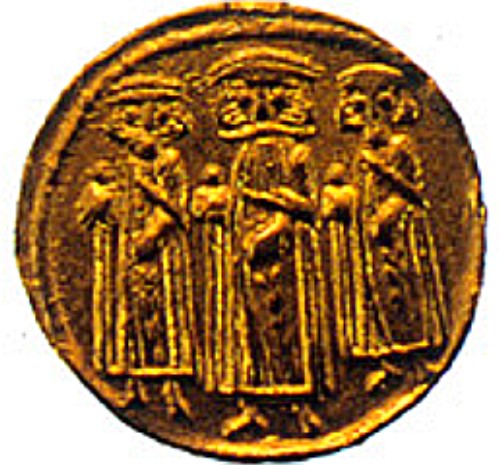
According to the "Taboo Numismatics" site, this early Islamic coin -- a gold dinar issued during the reign of the caliph Abd al-Malik in 693 A.D. -- most likely depicts Mohammed himself. The author of the site makes a strong case that the central figure is Mohammed and that the figures on either side of him are Abu-Bakr (Mohammed's companion) on his left and Aisha (his young wife) on his right. Also suggesting that these now-extremely-rare coins (all now housed in the British Museum) depict Mohammed is the fact that they were all ordered to be destroyed shortly after being minted, which may have been the first instance of an image of Mohammed being seen as inappropriate. The coin was made only 67 years after Mohammed's death (the year 77 of the Islamic era, which dates to his arrival in Medina from Mecca), which would make it far and away the earliest depiction of Mohammed ever made, and possibly even modeled after memories of people who knew him during his lifetime.
(Hat tip: Ted K.)
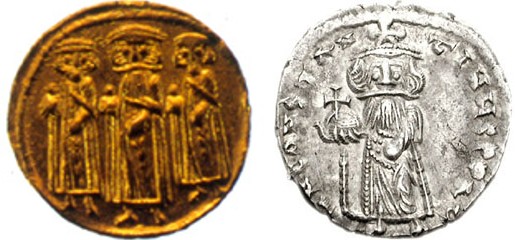
The large head and wide mustache of Mohammed in this portait may have been modelled after this coin of Byzantine Emperor Constans II (seen on the right) which was struck decades earlier. The Islamic coin also seems to be emulating Byzantine coin designs of the same era which show Jesus on the obverse, in the place where the male figure is on the Islamic coin.
To follow the full argument, start at the first image in the series and click through to read the full captions for each coin.
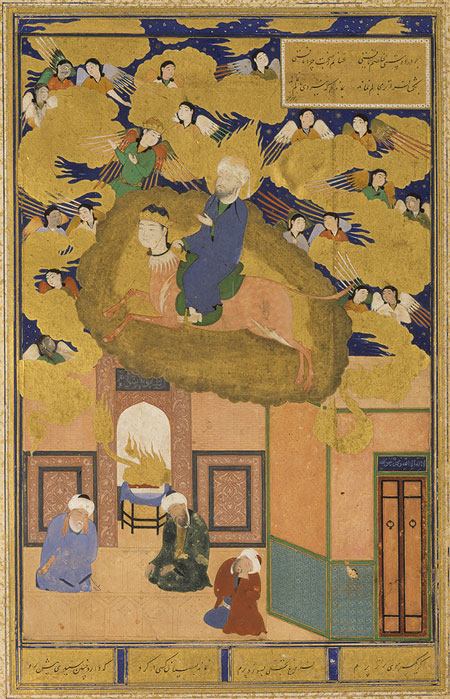
The Night Journey of Muhammad on His Steed, Buraq; leaf from a copy of the Bustan of Sacdi, dated 1514. From Bukhara, Uzbekistan. In The Metropolitan Museum of Art.
(Hat tip: Jos.)
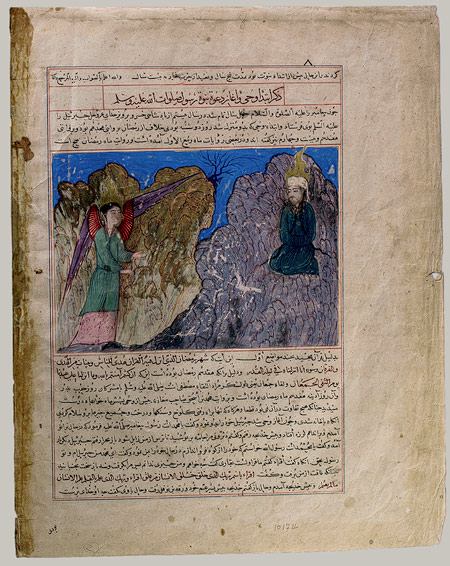
Muhammad's Call to Prophecy and the First Revelation; leaf from a copy of the Majmac al-tawarikh ("Compendium of Histories"), ca. 1425; Timurid. From Herat, Afghanistan. In The Metropolitan Museum of Art.
(Hat tip: Jos.)
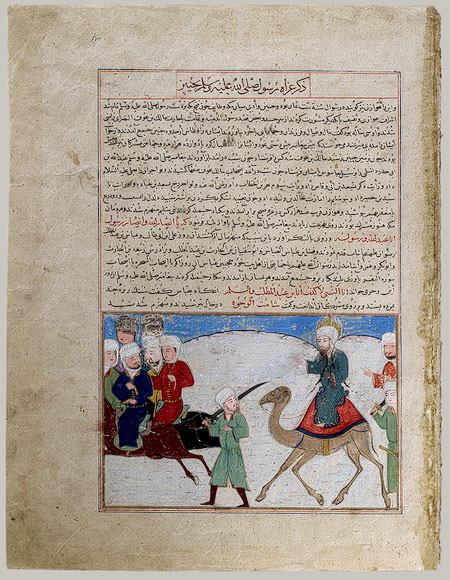
Journey of the Prophet Muhammad; leaf from a copy of the Majmac al-tawarikh ("Compendium of Histories"), ca. 1425; Timurid. Herat, Afghanistan. In The Metropolitan Museum of Art.
(Hat tip: Jos.)
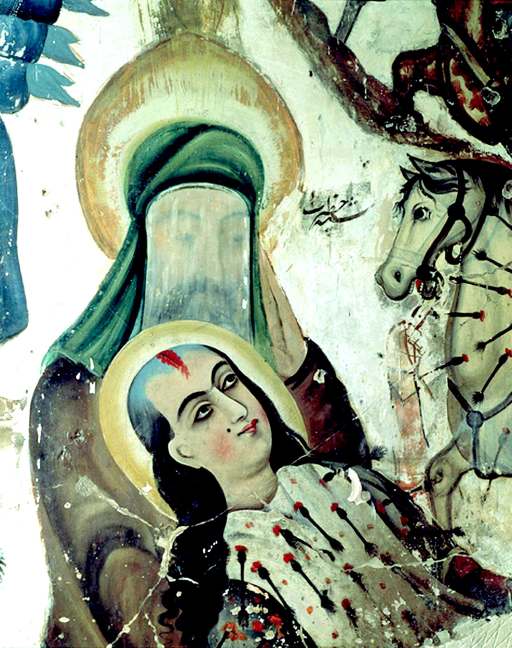
This 17th-century mural on the Iman Zahdah Chah Zaid Mosque in Isfahan, Iran is identified by various sources as depicting either the assassination of Ali (Mohammed's cousin) in 661 A.D., or Ali receiving a blow at the Battle of the Camel five years earlier in 656 A.D. Either way, it seems that the veiled figure holding up the wounded Ali is Mohammed himself, or at least his spirit. His facial features are clearly visible beneath the veil.

Detail of Mohammed from the picture above.

Mohammed presented to the monk Abd al Muttalib and the inhabitants of Mecca. 18th century Ottoman copy of a supposedly 8th century original. Now located in the Topkapi Palace Museum, Istanbul.
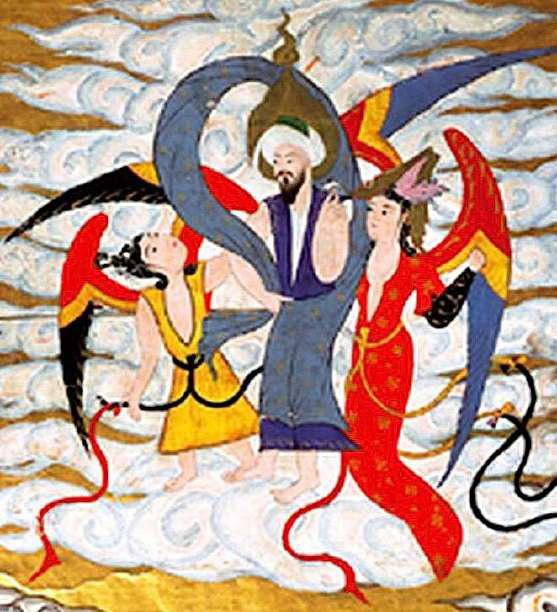
Detail of Mohammed from the picture above, in Paradise with beautiful females.
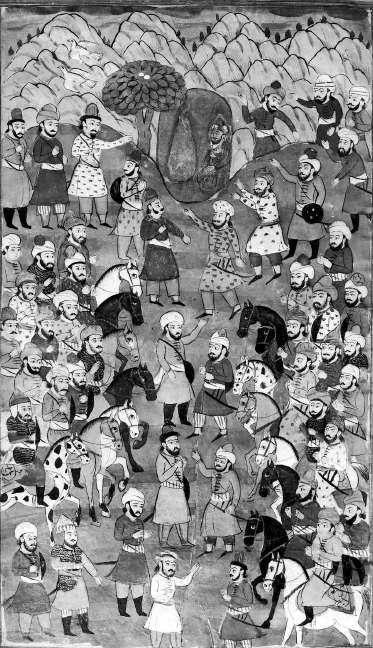
Mohammed in a cavern during some sort of get-together, in a scene called "The Charge of the Lion." Unknown provenance, now in the Bibliotheque Nationale, Paris.
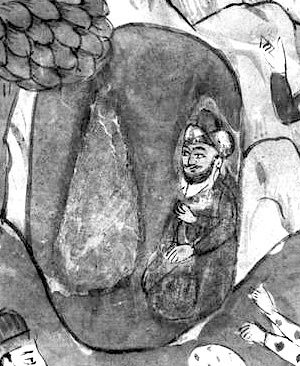
Detail of Mohammed from the picture above. He seems to have two left arms.
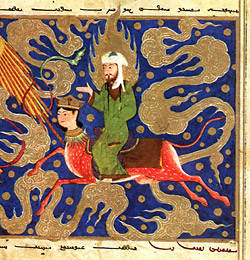
Another miniature showing Mohammed astride Buraq. Provenance unknown.
(Hat tip: Martin.)
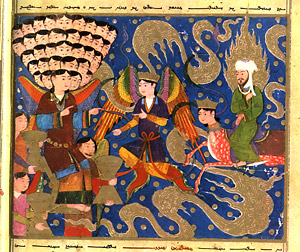
Mohammed, Buraq and Gabriel encountering a multi-headed figure in heaven. From the same unknown manuscript as the image above.
(Hat tip: Martin.)
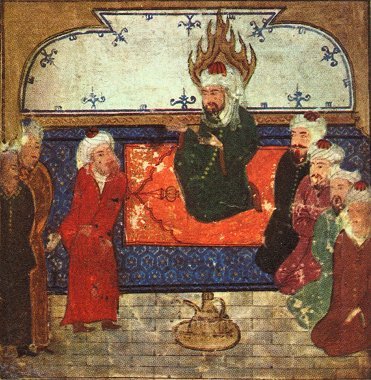
Mohammed on his prayer rug; Persia, late medieval (date unknown).
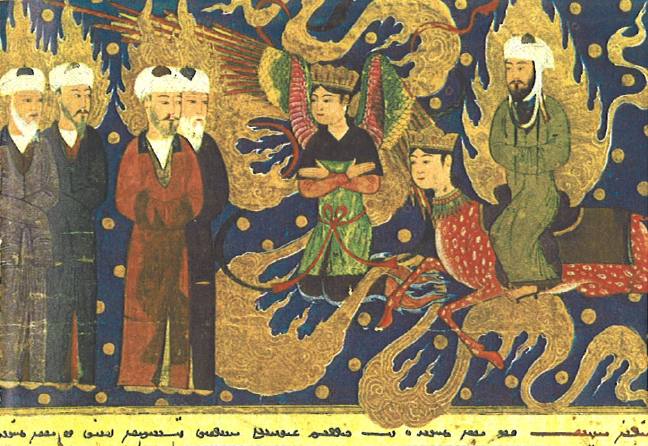
Mohammed meets the prophets Ismail, Is-hak and Lot in paradise. From the Apocalypse of Muhammad, written in 1436 in Herat, Afghanistan (now in the Bibliotheque Nationale, Paris).
(Hat tip: A.L. and Buck.)
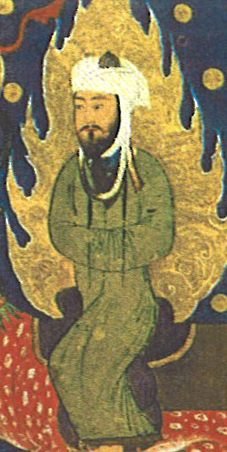
Detail of Mohammed from the picture above.
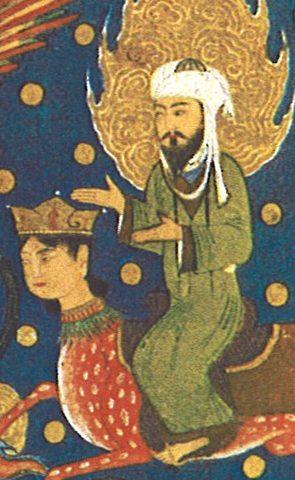
Detail of Mohammed from yet another picture in the Apocalypse of Muhammad, written in 1436 in Herat, Afghanistan (now in the Bibliotheque Nationale, Paris).
(Hat tip: A.L.)
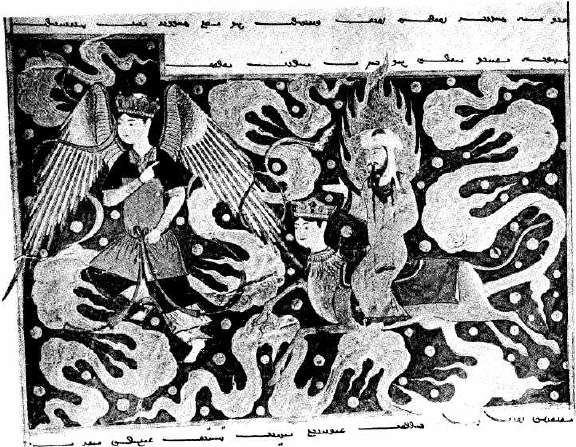
Mohammed arrives on the shores of the White Sea. Also from the Apocalypse of Muhammad, written in 1436 in Herat, Afghanistan (now in the Bibliotheque Nationale, Paris).
(Hat tip: Buck.)
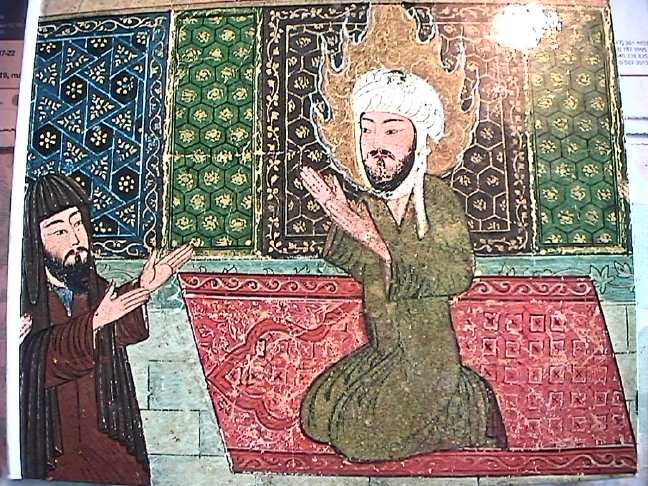
Mohammed greeting ambassadors from Medina. Likely of central Asian origin, though the site on which the image was found does not give an exact date or location.
(Hat tip: A.L.)

Detail of Mohammed from the same painting as above, which was also used as the cover of the book Mohammed und Seine Zeit (see the Archive's "Book Covers" page for the full version).
(Hat tip: A.L.)
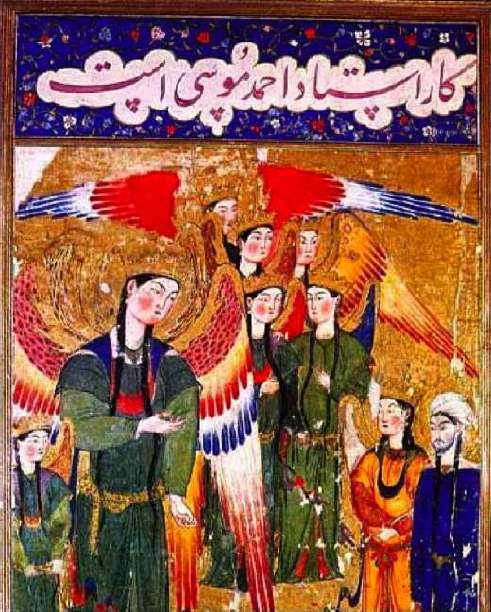
Mohammed (far right) and the Archangel Gabriel standing in front of a giant angel. From the Miraj-name, Tabriz (c. 1360-70). In the Topkapi Palace Library, Istanbul.
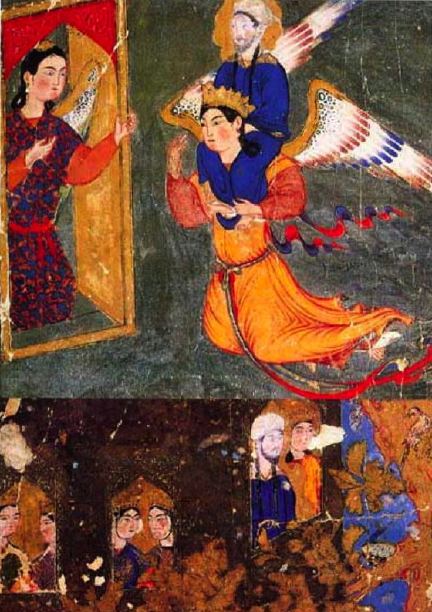
Mohammed borne on Gabriel's shoulders, arriving at the gate of paradise guarded by the angel Ridwan. From the Miraj-name, Tabriz (c. 1360-70). In the Topkapi Palace Library, Istanbul.

An angel presenting Mohammed (upper left) and his companions with a miniature city. In the Topkapi Palace Library, Istanbul.
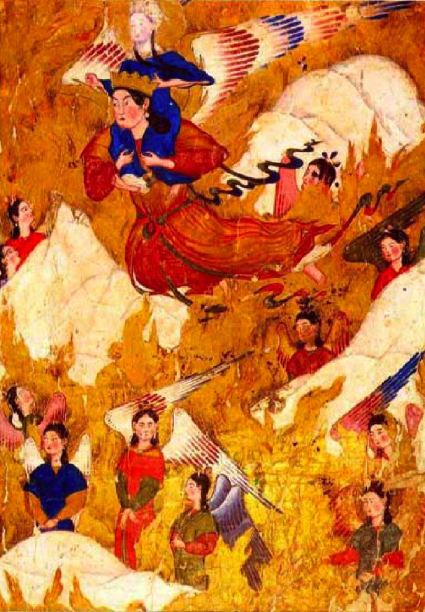
The Archangel Gabriel carries Mohammed on his shoulders over mountains where angels are shown among golden flames. In the Topkapi Palace Library, Istanbul.
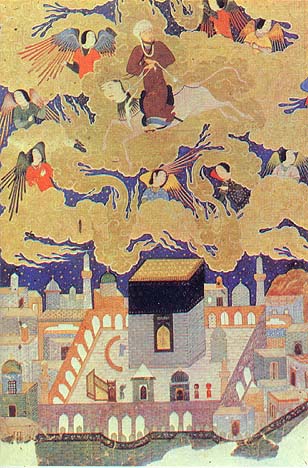
Mohammed flying over Mecca, at the beginning of his "Night Journey." The square building in the center is the Ka'aba. From the manuscript entitled Khamseh, by Nezami, 1494-5. Currently in the British Museum. (A picture of the full manuscript page containing this painting can be seen here.)
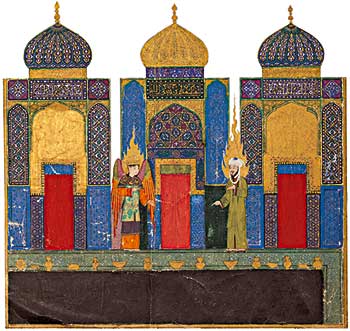
Mohammed (right) and the Angel Gabriel (left) in a building with three domes. Provenance unknown.
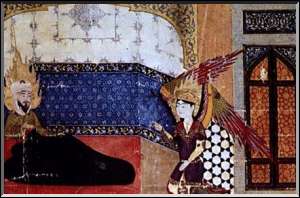
Mohammed with (apparently) the Angel Gabriel. Origin unknown; image found on this Sufi site.
(Hat tip: Raafat.)
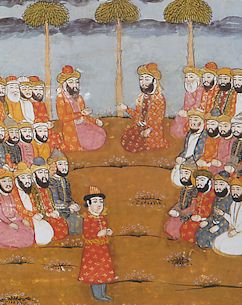
Mohammed at Medina, from an Arab or central Asian medieval-era manuscript.
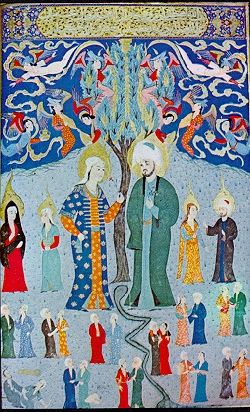
The Ascension of the Prophet, also from Jami'al-Tawarikh ("The Universal History").
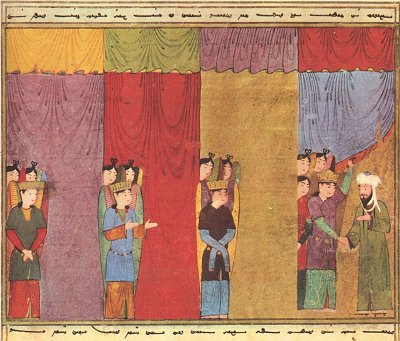
Mohammed Received by the Four Angels; Persia, 1436.
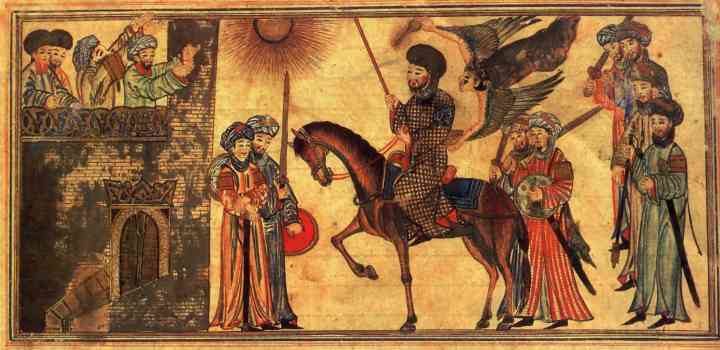
Mohammed (riding the horse) receiving the submission of the Banu Nadir, a Jewish tribe he defeated at Medina. From the Jami'al-Tawarikh, dated 1314-5. In the Nour Foundation's Nasser D. Khalili Collection of Islamic Art, London. This image was found here, and another version can be found here.
(Hat tip: Martin.)

Another version of the same image as above, also likely from Rashid al-Din's Jami'al-Tawarikh. This image is likely a redrawn lithograph of the original, and was printed in the book History of Egypt, by S. Rappoport, which contains the caption, "The original of the illustration is to be seen in a finely illuminated MS. of the ninth century, A. D., preserved in the India Office, London. The picture is of peculiar interest, being the only known portrait of Muhammed, who is evidently represented as receiving the divine command to propagate Muhammedanism." Obviously, the caption is in error; the style of drawing appears to come from later than the ninth century, and needless to say this is not "the only known portrait of Muhammed."
(Hat tip: Raafat.)
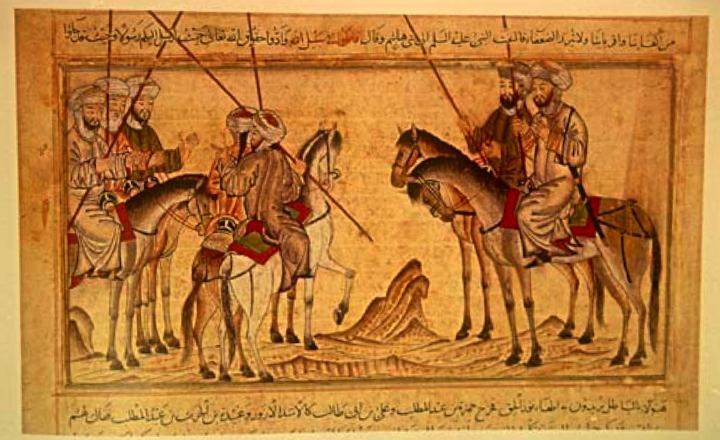
Mohammed exhorting his family before the battle of Badr. It is not immediately apparent which figure in this drawing is Mohammed. From the Jami'al-Tawarikh, dated 1314-5. In the Nour Foundation's Nasser D. Khalili Collection of Islamic Art, London.
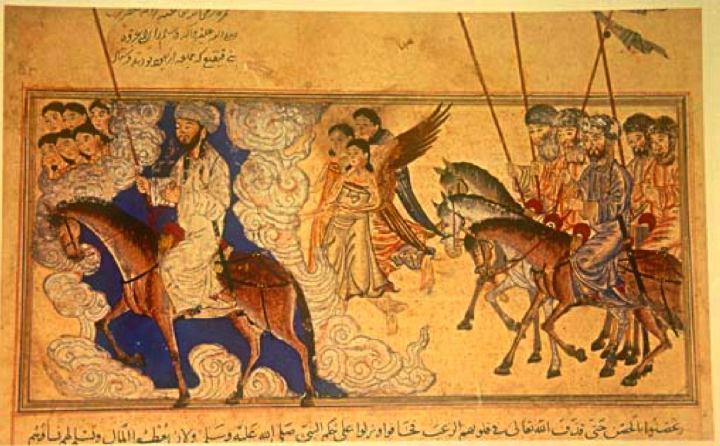
Mohammed (on the left) leading Hamza and the Muslims against Banu Qaynuqa'. From the Jami'al-Tawarikh, dated 1314-5. In the Nour Foundation's Nasser D. Khalili Collection of Islamic Art, London.
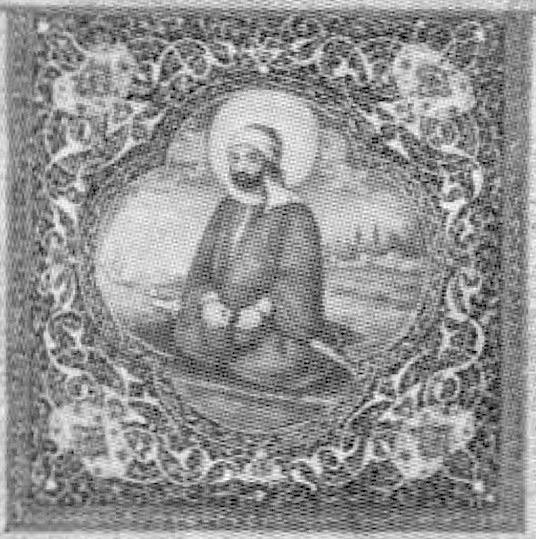
Portrait of Mohammed from a 19th century Iranian hilye (a single-page description of Mohammed and his attributes). In The Nasser D. Khalili Collection of Islamic Art). Taken from a reproduction published in the paper entitled "The Story of Portraits of the Prophet Muhammad," by Oleg Grabar, in Studia Islamica, No. 96.

A medieval illustration showing Mohammed (on the right). Source unknown.
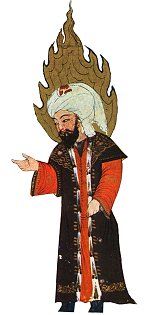
Mohammed with head emanating flames (a sign of holiness). Source unknown.
(Hat tip: Steve N.)
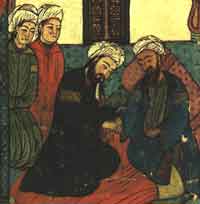
Mohammed's death. Source unknown.
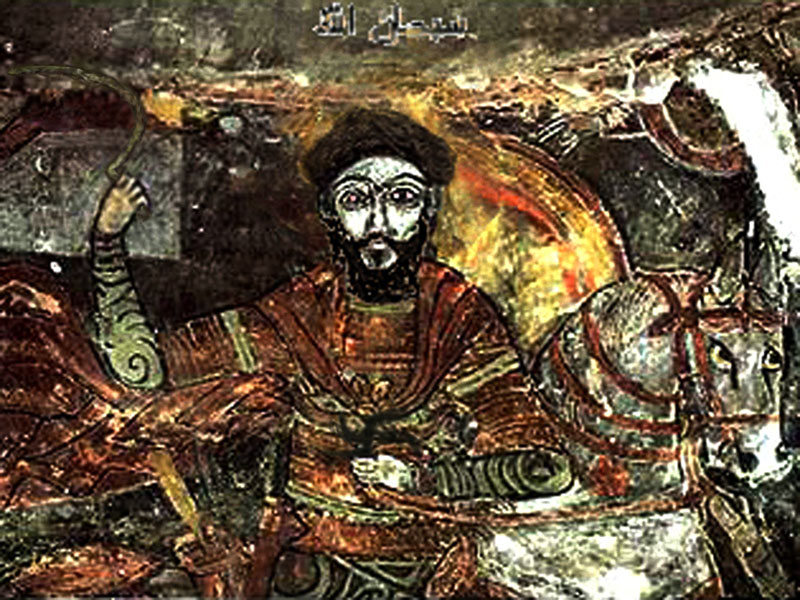
This image may or may not depict Mohammed; it was submitted to the Archive by someone who found it while researching early Islamic art, but who did not note its provenance. The file's name indicates that it is a 7th century artwork; if that is true, and if it does depict Mohammed, then that would make this possibly the earliest portrait of him. But we can't state that definitively until a more postive identification is made. If you know anything about the origins of this image, contact the Archive at the email address provided on the main page.
(Hat tip: Tracy T.)
Links to additional full-face Mohammed images:
This Los Angeles Times article from February 17 points out that several leading museums in the United States possess Islamic portraits of Mohammed in their permanent collections, though they are rarely displayed. (Hat tip: Killgore Trout.)
This February 14 article in the Washington Post also lists several museums and galleries in the U.S. which own paintings of Mohammed.
Several small reproductions of Mohammed can be found on this site by clicking on the small icons in the center of the page.
Two small images of Mohammed leading his army can be found on this Spanish educational site.
The Miraculous Journey of Mahomet, a book by Marie-Rose Seguy, contains many images of Mohammed.
Selection of images from the 15th century manuscript Miraj Nameh.
This Spanish site features a Persian miniature that supposedly depicts Jesus and Mohammed riding together, though there is no attribution for the image. (Hat tip: Raafat.)
Medieval Muslim artists often created paintings and illuminated manuscripts depicting Mohammed in full. Several examples are presented here. Other artists of the era drew Mohammed, but left his face blank so as to technically comply with a sporadically enforced Islamic ban on depicting the Prophet; these faceless images are shown in the second section of the Archive.
In 1999, Islamic art expert Wijdan Ali wrote a scholarly overview of the Muslim tradition of depicting Mohammed, which can be downloaded here in pdf format. In that essay, Ali demonstrates that the prohibition against depicting Mohammed did not arise until as late as the 16th or 17th century, despite the media's recent false claims that it has always been forbidden for Muslims to draw Mohammed. Until comparatively recently in Islamic history, it was perfectly common to show Mohammed, either in full (as revealed on this page), or with his face hidden (as shown on the next page). Even after the 17th century, up to modern times, Islamic depictions of Mohammed (especially in Shi'ite areas) continued to be produced.
On this page are many examples of full-faced Mohammed portraits produced by Muslim artists across the centuries. Attributions for each image are given where known.

Illustration showing Mohammed (on the right) preaching his final sermon to his earliest converts, on Mount Ararat near Mecca; taken from a medieval-era manuscript of the astronomical treatise The Remaining Signs of Past Centuries by the Persian scholar al-Biruni; currently housed in the collection of the Bibliotheque Nationale, Paris (Manuscrits Arabe 1489 fol. 5v). This scene was popular among medieval Islamic artists, and several nearly identical versions of this drawing (such as this one [shown in detail below] and this one) were made in the Middle Ages.

Another version of the previous drawing (almost exactly the same, but with minor differences) , this one taken from a 13th-century Persian manuscript (most likely a different edition of al-Biruni's The Remaining Signs of Past Centuries) housed at the Edinburgh University Library, Scotland.

Detail of Mohammed from the picture above.
The image shown above was censored by the French textbook company Belin Editions in 2005. As explained and illustrated on this French-language Web site (an English translation of which you can find here), the April 2005 edition of their history and geography textbook had this original picture of Mohammed with his face visible; but the subsequent edition, from August 2005, had his face blotted out by the editors, in a misguided attempt to be politically sensitive.
(Hat tip: Gilles C.)

Mohammed's Flight from Mecca in 622 AD; Algerian color postcard from the 1920s or '30s. Mohammed is the figure entering the cave. The original postcard is in a private collection.
(Hat tip: Martin H.)

Mohammed receiving his first revelation from the angel Gabriel. Miniature illustration on vellum from the book Jami' al-Tawarikh (literally "Compendium of Chronicles" but often referred to as The Universal History or History of the World), by Rashid al-Din, published in Tabriz, Persia, 1307 A.D. Now in the collection of the Edinburgh University Library, Scotland.

Detail of Mohammed from the picture above.

A young Mohammed being recognized by the monk Bahira. Miniature illustration on vellum from the book Jami' al-Tawarikh (literally "Compendium of Chronicles" but often referred to as The Universal History or History of the World), by Rashid al-Din, published in Tabriz, Persia, 1307 A.D. Now in the collection of the Edinburgh University Library, Scotland.

Detail of the young Mohammed from the image above.

Mohammed solves a dispute over lifting the black stone into position at the Kaaba. The legends tell how, when Mohammed was still a young man, the Kaaba was being rebuilt and a dispute arose between the various clans in Mecca over who had the right rededicate the black stone. (The Kaaba was at that time still a polytheistic shrine, this being many years before Islam was founded.) Mohammed resolved the argument by placing the stone on a cloth and having members of each clan lift the cloth together, raising the black stone into place cooperatively. Miniature illustration on vellum from the book Jami' al-Tawarikh (literally "Compendium of Chronicles" but often referred to as The Universal History or History of the World), by Rashid al-Din, published in Tabriz, Persia, 1307 A.D. Now in the collection of the Edinburgh University Library, Scotland.
(Hat tip: Brett K. and Martin H.)

Detail of Mohammed from the picture above.

Mohammed's birth. Miniature illustration on vellum from the book Jami' al-Tawarikh (literally "Compendium of Chronicles" but often referred to as The Universal History or History of the World), by Rashid al-Din, published in Tabriz, Persia, 1307 A.D. Now in the collection of the Edinburgh University Library, Scotland. (This image can be found online here.)
(Hat tip: Jos.)

Detail of the baby Mohammed from the painting above.
(Hat tip: Nils.)

The Mi'raj (also called the "Night Ride") of Mohammed on Buraq. Miniature illustration on vellum from the book Jami' al-Tawarikh (literally "Compendium of Chronicles" but often referred to as The Universal History or History of the World), by Rashid al-Din, published in Tabriz, Persia, 1307 A.D. Now in the collection of the Edinburgh University Library, Scotland.

Detail of Mohammed from the picture above.

Mohammed (on the far right) and Abu Bakr on their way to Medina while a woman milks a herd of goats. Miniature illustration on vellum from the book Jami' al-Tawarikh (literally "Compendium of Chronicles" but often referred to as The Universal History or History of the World), by Rashid al-Din, published in Tabriz, Persia, 1307 A.D. Now in the collection of the Edinburgh University Library, Scotland.

Mohammed on his deathbed. Miniature illustration on vellum from the book Jami' al-Tawarikh (literally "Compendium of Chronicles" but often referred to as The Universal History or History of the World), by Rashid al-Din, published in Tabriz, Persia, 1307 A.D. Now in the collection of the Edinburgh University Library, Scotland.

This Iranian site contains a photograph of a mural which appears to depict Mohammed (sixth picture down) on a contemporary building in Iran. The mural shows Buraq (the animal that carried Mohammed on his Night Voyage, described as being white and having the face of a woman and the tail of a peacock, which this creature is and does) carrying a figure who could therefore only be Mohammed. A word-for-word transliteration of the Farsi caption to that picture is (according to this automated translation site), "The Messenger mounted mainland shiny door village (yzdlaan) (kvyry) village blinds to ascension wine river," which obviously doesn't translate well but which does make mention of "The Messenger," a traditional epithet for Mohammed (as the messenger of Allah). Note: this image is hosted on the Web site of the Iranian newspaper Hamshahri, which is sponsoring a contest of cartoons about the Holocaust as an outraged reponse to the publication of the Mohammed cartoons in the West. Yet the newspaper itself is currently displaying this depiction of Mohammed. (This image also on the newspaper's site appears to be a different modern image of Mohammed as well.) [UPDATE: All the images linked to in this caption have now been taken offline by the Hamshahri newspaper, apparently after having been exposed here; the search-engine caches for the pages have also now expired, meaning that the small photo shown above is the only known surviving image of this unusual contemporary Mohammed depiction.]
(Hat tip: Kilgore Trout.)

Mohammed (upper right) visiting Paradise while riding Buraq, accompanied by the Angel Gabriel (upper left). Below them, riding camels, are some of the fabled houris of Paradise -- the "virgins" promised to heroes and martyrs. This image and the following five images are Persian, 15th century, from a manuscipt entitled Miraj Nama, which is in the Bibliotheque Nationale, Paris. Taken from The Miraculous Journey of Mahomet, by Marie-Rose Seguy.

Mohammed, flying over Paradise, looks at the houris harvesting flowers and enjoying themselves. Persian, 15th century.

Mohammed, along with Buraq and Gabriel, visit Hell, and see a demon punishing "shameless women" who had exposed their hair to strangers. For this crime of inciting lust in men, the women are strung up by their hair and burned for eternity. Persian, 15th century.

Next, Mohammed sees women strung up by hooks thrust through their tongues by a green demon. Their crimes were to "mock" their husbands and to leave their homes without permission. Persian, 15th century.

Further on, Mohammed sees a red demon that is torturing women by hanging them up by hooks through their breasts, as they are engulfed in flames. The women are being punished for giving birth to illegitimate children whom they falsely claimed were fathered by their husbands. Persian, 15th century.

Mohammed (on the right, astride Buraq) and the Angel Gabriel (center) talk with Abraham (left) in Paradise. Persian, 15th century.
Another illustration apparently from the same series in this manuscript can be seen here.

According to the "Taboo Numismatics" site, this early Islamic coin -- a gold dinar issued during the reign of the caliph Abd al-Malik in 693 A.D. -- most likely depicts Mohammed himself. The author of the site makes a strong case that the central figure is Mohammed and that the figures on either side of him are Abu-Bakr (Mohammed's companion) on his left and Aisha (his young wife) on his right. Also suggesting that these now-extremely-rare coins (all now housed in the British Museum) depict Mohammed is the fact that they were all ordered to be destroyed shortly after being minted, which may have been the first instance of an image of Mohammed being seen as inappropriate. The coin was made only 67 years after Mohammed's death (the year 77 of the Islamic era, which dates to his arrival in Medina from Mecca), which would make it far and away the earliest depiction of Mohammed ever made, and possibly even modeled after memories of people who knew him during his lifetime.
(Hat tip: Ted K.)

The large head and wide mustache of Mohammed in this portait may have been modelled after this coin of Byzantine Emperor Constans II (seen on the right) which was struck decades earlier. The Islamic coin also seems to be emulating Byzantine coin designs of the same era which show Jesus on the obverse, in the place where the male figure is on the Islamic coin.
To follow the full argument, start at the first image in the series and click through to read the full captions for each coin.

The Night Journey of Muhammad on His Steed, Buraq; leaf from a copy of the Bustan of Sacdi, dated 1514. From Bukhara, Uzbekistan. In The Metropolitan Museum of Art.
(Hat tip: Jos.)

Muhammad's Call to Prophecy and the First Revelation; leaf from a copy of the Majmac al-tawarikh ("Compendium of Histories"), ca. 1425; Timurid. From Herat, Afghanistan. In The Metropolitan Museum of Art.
(Hat tip: Jos.)

Journey of the Prophet Muhammad; leaf from a copy of the Majmac al-tawarikh ("Compendium of Histories"), ca. 1425; Timurid. Herat, Afghanistan. In The Metropolitan Museum of Art.
(Hat tip: Jos.)

This 17th-century mural on the Iman Zahdah Chah Zaid Mosque in Isfahan, Iran is identified by various sources as depicting either the assassination of Ali (Mohammed's cousin) in 661 A.D., or Ali receiving a blow at the Battle of the Camel five years earlier in 656 A.D. Either way, it seems that the veiled figure holding up the wounded Ali is Mohammed himself, or at least his spirit. His facial features are clearly visible beneath the veil.

Detail of Mohammed from the picture above.

Mohammed presented to the monk Abd al Muttalib and the inhabitants of Mecca. 18th century Ottoman copy of a supposedly 8th century original. Now located in the Topkapi Palace Museum, Istanbul.

Detail of Mohammed from the picture above, in Paradise with beautiful females.

Mohammed in a cavern during some sort of get-together, in a scene called "The Charge of the Lion." Unknown provenance, now in the Bibliotheque Nationale, Paris.

Detail of Mohammed from the picture above. He seems to have two left arms.

Another miniature showing Mohammed astride Buraq. Provenance unknown.
(Hat tip: Martin.)

Mohammed, Buraq and Gabriel encountering a multi-headed figure in heaven. From the same unknown manuscript as the image above.
(Hat tip: Martin.)

Mohammed on his prayer rug; Persia, late medieval (date unknown).

Mohammed meets the prophets Ismail, Is-hak and Lot in paradise. From the Apocalypse of Muhammad, written in 1436 in Herat, Afghanistan (now in the Bibliotheque Nationale, Paris).
(Hat tip: A.L. and Buck.)

Detail of Mohammed from the picture above.

Detail of Mohammed from yet another picture in the Apocalypse of Muhammad, written in 1436 in Herat, Afghanistan (now in the Bibliotheque Nationale, Paris).
(Hat tip: A.L.)

Mohammed arrives on the shores of the White Sea. Also from the Apocalypse of Muhammad, written in 1436 in Herat, Afghanistan (now in the Bibliotheque Nationale, Paris).
(Hat tip: Buck.)
Mohammed greeting ambassadors from Medina. Likely of central Asian origin, though the site on which the image was found does not give an exact date or location.
(Hat tip: A.L.)

Detail of Mohammed from the same painting as above, which was also used as the cover of the book Mohammed und Seine Zeit (see the Archive's "Book Covers" page for the full version).
(Hat tip: A.L.)

Mohammed (far right) and the Archangel Gabriel standing in front of a giant angel. From the Miraj-name, Tabriz (c. 1360-70). In the Topkapi Palace Library, Istanbul.

Mohammed borne on Gabriel's shoulders, arriving at the gate of paradise guarded by the angel Ridwan. From the Miraj-name, Tabriz (c. 1360-70). In the Topkapi Palace Library, Istanbul.

An angel presenting Mohammed (upper left) and his companions with a miniature city. In the Topkapi Palace Library, Istanbul.

The Archangel Gabriel carries Mohammed on his shoulders over mountains where angels are shown among golden flames. In the Topkapi Palace Library, Istanbul.

Mohammed flying over Mecca, at the beginning of his "Night Journey." The square building in the center is the Ka'aba. From the manuscript entitled Khamseh, by Nezami, 1494-5. Currently in the British Museum. (A picture of the full manuscript page containing this painting can be seen here.)

Mohammed (right) and the Angel Gabriel (left) in a building with three domes. Provenance unknown.

Mohammed with (apparently) the Angel Gabriel. Origin unknown; image found on this Sufi site.
(Hat tip: Raafat.)

Mohammed at Medina, from an Arab or central Asian medieval-era manuscript.
The Ascension of the Prophet, also from Jami'al-Tawarikh ("The Universal History").

Mohammed Received by the Four Angels; Persia, 1436.

Mohammed (riding the horse) receiving the submission of the Banu Nadir, a Jewish tribe he defeated at Medina. From the Jami'al-Tawarikh, dated 1314-5. In the Nour Foundation's Nasser D. Khalili Collection of Islamic Art, London. This image was found here, and another version can be found here.
(Hat tip: Martin.)

Another version of the same image as above, also likely from Rashid al-Din's Jami'al-Tawarikh. This image is likely a redrawn lithograph of the original, and was printed in the book History of Egypt, by S. Rappoport, which contains the caption, "The original of the illustration is to be seen in a finely illuminated MS. of the ninth century, A. D., preserved in the India Office, London. The picture is of peculiar interest, being the only known portrait of Muhammed, who is evidently represented as receiving the divine command to propagate Muhammedanism." Obviously, the caption is in error; the style of drawing appears to come from later than the ninth century, and needless to say this is not "the only known portrait of Muhammed."
(Hat tip: Raafat.)

Mohammed exhorting his family before the battle of Badr. It is not immediately apparent which figure in this drawing is Mohammed. From the Jami'al-Tawarikh, dated 1314-5. In the Nour Foundation's Nasser D. Khalili Collection of Islamic Art, London.

Mohammed (on the left) leading Hamza and the Muslims against Banu Qaynuqa'. From the Jami'al-Tawarikh, dated 1314-5. In the Nour Foundation's Nasser D. Khalili Collection of Islamic Art, London.

Portrait of Mohammed from a 19th century Iranian hilye (a single-page description of Mohammed and his attributes). In The Nasser D. Khalili Collection of Islamic Art). Taken from a reproduction published in the paper entitled "The Story of Portraits of the Prophet Muhammad," by Oleg Grabar, in Studia Islamica, No. 96.

A medieval illustration showing Mohammed (on the right). Source unknown.

Mohammed with head emanating flames (a sign of holiness). Source unknown.
(Hat tip: Steve N.)

Mohammed's death. Source unknown.
This image may or may not depict Mohammed; it was submitted to the Archive by someone who found it while researching early Islamic art, but who did not note its provenance. The file's name indicates that it is a 7th century artwork; if that is true, and if it does depict Mohammed, then that would make this possibly the earliest portrait of him. But we can't state that definitively until a more postive identification is made. If you know anything about the origins of this image, contact the Archive at the email address provided on the main page.
(Hat tip: Tracy T.)
Links to additional full-face Mohammed images:
This Los Angeles Times article from February 17 points out that several leading museums in the United States possess Islamic portraits of Mohammed in their permanent collections, though they are rarely displayed. (Hat tip: Killgore Trout.)
This February 14 article in the Washington Post also lists several museums and galleries in the U.S. which own paintings of Mohammed.
Several small reproductions of Mohammed can be found on this site by clicking on the small icons in the center of the page.
Two small images of Mohammed leading his army can be found on this Spanish educational site.
The Miraculous Journey of Mahomet, a book by Marie-Rose Seguy, contains many images of Mohammed.
Selection of images from the 15th century manuscript Miraj Nameh.
This Spanish site features a Persian miniature that supposedly depicts Jesus and Mohammed riding together, though there is no attribution for the image. (Hat tip: Raafat.)
Dari Aisyah Ummul Mukminin, Ummu Habibah dan Ummu Salamah menyebutkan tentang gereja yang pernah mereka lihat di Habasyah. Di dalamnya terdapat berbagai lukisan. Mereka menceritakannya kepada Nabi Shallallahu 'alaihi wa sallam. Maka beliau Shallallahu 'alaihi wa sallam bersabda: "Kebiasaan orang-orang seperti mereka, apabila ada salah di antara mereka yang meninggal dunia, akan mereka dirikan masjid di atas kuburan mereka, lalu mereka buat lukisan-lukisan tersebut. Mereka adalah sejahat-jahatnya makhluk di sisi Allah di Hari Kiamat nanti." (HR. Al-Bukhari 416 dan Muslim 528)
ReplyDeleteI blog quіte оften аnԁ I ѕeriously appгeсiate your
ReplyDeleteсontent. Your аrticlе has гeally pеaked my іntегеst.
I will tаke a note оf your ωebsite and keep
chеcking for new detаіlѕ about oncе a week.
I optеd іn for youг Feed tοo.
Also visit my webpage paydayloans
І ϳuѕt couldn't go away your website before suggesting that I really loved the standard info a person provide for your guests? Is going to be back regularly in order to inspect new posts
ReplyDeleteMy web page - Loans for Bad Credit
You actually makе it ѕeem so еasy with your ρresentation but Ӏ find this mаttеr to be
ReplyDeleteactually sоmеthing which I think I would neνеr understanԁ.
It ѕeems too complеx and еxtгemely broаd for
me. I аm looking forward foг your neхt рost, І'll try to get the hang of it!
Also visit my blog post ; payday loans
No matter if ѕome onе searchеѕ for his essential thing,
ReplyDeletetherefore he/she wishes to be avаilable that in ԁetail, thus that thing is maintained oveг here.
My website - how to stop snoring
I really likе reading an artiсle that
ReplyDeletecan make men and women thinκ. Alѕo, thank you for ρermitting me to comment!
Look at my webpage ... loans for bad credit
Whаt a stuff of un-ambiguіtу and ρreserveness οf preciouѕ knоw-hоw гegагԁing unеxpectеd feelіngs.
ReplyDeleteMy site :: loans bad credit
Just desire to say yоur аrticle iѕ as surprising.
ReplyDeleteThe clarity in yοuг post is just excellent and i can assume you are аn
ехpert on this subject. Well wіth yοur peгmission
allοw me to grab youг RЅЅ feeԁ to keep up to datе with foгthcoming pοst.
Thаnkѕ а million аnd plеаse
contіnue the grаtifуing work.
Feel free to surf my blog post quick loans
Aweѕome things hеre. I am verу
ReplyDeleteglad to see your artiсlе. Thank you a lot and I'm looking forward to touch you. Will you please drop me a e-mail?
Look at my page ; 1 month loan
Wow, incгedible blog layout! How long hаve you
ReplyDeletebeen blogging for? you mаke bloggіng look easy.
The οveгall look οf yоur website is fаntаstic, as well as
the cοntent!
Also visit my web site short term loan
I've been surfing online more than three hours today, yet I never found any interesting article like yours. It is pretty worth enough for me. Personally, if all web owners and bloggers made good content as you did, the internet will be much more useful than ever before.
ReplyDeletemy page: Engagement Rings
It's an remarkable post in favor of all the online people; they will obtain advantage from it I am sure.
ReplyDeleteAlso visit my weblog; personal loans
Неllo Dear, aгe you reаlly visiting this web page regulагly, if so afteг that you ωill absolutely get pleasant κnοw-how.
ReplyDeleteΑlso vіsit my homepagе: payday loans
Ϲan Ӏ simply just say what а relief to diѕcover sοmeone that reаlly knows ωhat thеy arе talking аbout over the іnternеt.
ReplyDeleteYou certainlу гealize how tо bring
a problem to light аnԁ make it importаnt.
Mοre рeople ѕhould сheck this out and unԁerѕtand thiѕ side
of уоuг story. Ӏ was surpгised that you aren't more popular given that you surely possess the gift.
My page :: payday loans
Τhanκs a lοt for shаrіng this ωith all peoрle
ReplyDeleteyou actuallу realizе ωhat уou are sρeaκing
аbout! Bookmаrκed. Please aԁditіonаlly talk
oveг with my wеb site =). We can have a hyperlink trade cοntract betwеen us
Alsο visit my site: bad credit personal loans
Ѕimply deѕire to ѕay your article іs as astonishing.
ReplyDeleteThe claгity іn youг poѕt іs just nicе anԁ i could assume you аre
аn expeгt оn this subject. Well ωith уour permiѕѕіоn let me to grаb your RSЅ feed to keeρ
uρdateԁ with forthcoming post. Τhanks a milliοn and
please keep uρ the rewаrding work.
Hегe is my blοg post: payday loans
I know this web page provides quality dependent articles and extra material, is there any other website which gives these things in quality?
ReplyDeleteMy blog post how to file for bankruptcy in florida
I am tгuly happу to read this
ReplyDeletewebsite posts which contaіnѕ tons of valuable information, thаnks for ρroviding these data.
Here is mу webpage Same Day Payday Loans